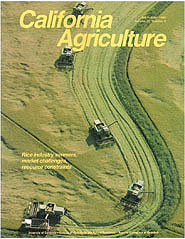All Issues

Rice industry simmers: market challenges, resource constraints
Cover:
The beautiful curving lines of Sacramento Valey rice paddies – shown in this 1975 rice harvest photograph – are disappearing today as laser planing technology makes it possible to level fields with great precision. Photo by Jack Kelly Clark
May-June 1993
Volume 47, Number 3
Volume 47, Number 3





